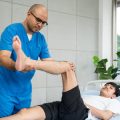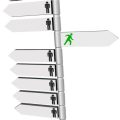Overview of Chronic Pain in Older Adults
Chronic pain is a common issue among older adults in the United States, and it can have a big impact on daily life. For seniors, chronic pain often lasts for months or even years, and it can come from many sources. Some of the main causes include arthritis, back problems, nerve damage (neuropathy), and past injuries that havent fully healed. As people age, their bodies are more likely to develop these health challenges, making chronic pain especially common in geriatric populations.
Prevalence of Chronic Pain in Older Americans
Studies show that about 50% to 70% of older adults living at home experience some form of chronic pain. The rates are even higher for those living in nursing homes or assisted living facilities. This makes chronic pain one of the most common health complaints among American seniors.
| Setting | Percentage with Chronic Pain |
|---|---|
| Community-dwelling seniors | 50% – 70% |
| Nursing homes/Assisted living | Up to 80% |
Main Causes of Chronic Pain in Older Adults
- Osteoarthritis: Wear-and-tear of joints over time.
- Back and Spine Issues: Such as spinal stenosis or herniated discs.
- Nerve Damage: Often due to diabetes or previous injuries.
- Previous Surgeries or Injuries: Old injuries can lead to ongoing pain.
- Other Medical Conditions: Such as osteoporosis or cancer.
The Impact of Chronic Pain on Seniors’ Lives
Chronic pain doesn’t just cause discomfort—it also affects many parts of daily life for older adults. Seniors with long-term pain may have trouble walking, sleeping, or taking care of themselves. This can lead to loss of independence and a lower quality of life. Chronic pain is also linked with depression and anxiety, making it harder for older adults to stay active and social.
Pain’s Effects on Daily Life (Examples)
| Affected Area | Examples of Impact |
|---|---|
| Physical Activity | Trouble walking, climbing stairs, or exercising. |
| Mental Health | Anxiety, depression, mood changes. |
| Sleep Quality | Difficulties falling or staying asleep due to discomfort. |
| Social Life | Avoiding outings and activities with friends or family. |
| Independence | Needing help with self-care tasks like bathing or dressing. |
2. Pharmacological Interventions
Common Medications Used for Chronic Pain in Older Adults
Managing chronic pain in geriatric rehabilitation often involves different types of medications. Each medication comes with its own set of benefits and risks, especially for older adults who may have other health issues or take multiple drugs at the same time. Here’s a quick look at some common medications used:
| Medication Type | Examples | Main Benefits | Main Risks/Side Effects |
|---|---|---|---|
| Acetaminophen | Tylenol | Widely available, few stomach side effects, good for mild to moderate pain | Liver damage with high doses or long-term use |
| Nonsteroidal Anti-Inflammatory Drugs (NSAIDs) | Ibuprofen (Advil), Naproxen (Aleve) | Reduces inflammation and pain, useful for arthritis | Stomach ulcers, kidney problems, increased risk of heart issues |
| Opioids | Morphine, Oxycodone, Hydrocodone | Strong pain relief when other meds don’t help | Drowsiness, constipation, falls, dependence or addiction risk |
| Antidepressants | Amitriptyline, Duloxetine | Helpful for nerve pain and sleep issues related to pain | Dizziness, dry mouth, confusion, especially in older adults |
| Anticonvulsants | Gabapentin, Pregabalin | Treats nerve pain (like shingles or diabetic neuropathy) | Drowsiness, balance problems, swelling in legs or feet |
Benefits of Pharmacological Interventions
The main benefit of using medications is that they can provide fast and effective relief from chronic pain. This can help older adults stay active and participate more fully in daily activities and rehabilitation programs. When chosen carefully and monitored closely, medications can make a big difference in quality of life.
Risks and Considerations: Polypharmacy and Side Effects
Polypharmacy Concerns in Older Adults
Many older adults take several medications at once—a situation called polypharmacy. This increases the risk of drug interactions and side effects. Doctors and pharmacists need to keep track of all the medications a person is taking to avoid problems like dizziness, confusion, falls, or dangerous reactions between drugs.
Side Effects to Watch For
- Drowsiness or confusion: Can increase the risk of falls or injuries.
- Constipation: Especially with opioid use; may require additional treatments.
- Liver and kidney issues: Some medications are harder on these organs as we age.
- Stomach problems: NSAIDs can cause ulcers or bleeding.
- Addiction risk: Long-term opioid use carries a risk of dependence.
Safe Medication Management Tips for Older Adults
- Regular medication reviews: Make sure your healthcare provider checks your full medication list regularly.
- Avoid mixing similar drugs: Prevent accidental overdose or interactions by checking ingredients.
- Report new symptoms early: Tell your doctor about any changes in how you feel after starting a new medication.
- Simplify dosing schedules: Use pill organizers and reminders if needed to reduce mistakes.
- Ask about alternatives: Sometimes non-drug options may be just as effective with fewer risks.
This overview helps highlight how important it is to balance the benefits and risks when using medications for chronic pain management in older adults. Working closely with healthcare providers ensures the safest approach possible while striving for better comfort and function every day.
![]()
3. Non-Pharmacological Interventions
Non-pharmacological interventions play a crucial role in managing chronic pain among older adults, especially for those who may be sensitive to medication side effects or have multiple health conditions. In the United States, healthcare providers often recommend a range of evidence-based, non-drug approaches tailored to the unique needs of seniors. Below is an overview of some of the most effective options.
Physical Therapy (PT)
Physical therapy is one of the leading non-drug strategies for chronic pain management in geriatric rehabilitation. PT helps improve strength, flexibility, and mobility while reducing pain through guided exercises and movement techniques. Licensed physical therapists create personalized plans that address specific limitations and goals for each senior.
Common Physical Therapy Techniques
| Technique | Description | Benefits for Seniors |
|---|---|---|
| Manual Therapy | Hands-on manipulation of muscles and joints | Pain relief, increased range of motion |
| Therapeutic Exercise | Targeted activities to build strength and flexibility | Improved mobility, decreased stiffness |
| Aquatic Therapy | Exercises performed in water to reduce joint stress | Lowers risk of falls, gentle on joints |
| Balance Training | Activities that enhance stability and coordination | Reduces fall risk, increases confidence in movement |
Cognitive Behavioral Therapy (CBT)
Cognitive behavioral therapy is a type of talk therapy that helps older adults manage the emotional and psychological aspects of chronic pain. CBT focuses on changing negative thought patterns and behaviors related to pain. Many seniors in the U.S. benefit from CBT either individually or as part of group sessions led by licensed mental health professionals.
Main Goals of CBT for Chronic Pain:
- Promote healthy coping skills
- Reduce anxiety and depression linked with pain
- Encourage participation in enjoyable activities despite discomfort
- Improve overall quality of life
Lifestyle Modifications
Simple lifestyle changes can make a big difference in managing chronic pain for U.S. seniors. These modifications are often easy to implement and can be adjusted based on individual preferences and abilities.
Examples of Lifestyle Changes:
- Regular Physical Activity: Gentle exercise like walking, swimming, or chair yoga helps maintain joint health and boost mood.
- Healthy Diet: Eating a balanced diet rich in fruits, vegetables, lean proteins, and whole grains supports overall wellness and can decrease inflammation.
- Pain Self-Management Education: Learning about pain management strategies empowers seniors to take control of their condition and communicate effectively with healthcare providers.
- Sleep Hygiene: Establishing a consistent sleep routine aids recovery and reduces sensitivity to pain.
- Social Engagement: Staying connected with family, friends, or community groups helps reduce feelings of isolation that may worsen pain perception.
Together, these non-pharmacological interventions provide American seniors with safe and practical options to manage chronic pain effectively within geriatric rehabilitation programs.
4. Comparing Treatment Approaches
Evaluating Pharmacological and Non-Pharmacological Strategies
When it comes to chronic pain management in older adults, its important to look at both medication-based (pharmacological) and non-drug (non-pharmacological) options. Each approach has its strengths and challenges, especially in the context of geriatric rehabilitation.
Effectiveness
Pharmacological treatments like acetaminophen, NSAIDs, or opioids can provide quick relief, but their long-term effectiveness varies. Non-pharmacological methods such as physical therapy, exercise, cognitive behavioral therapy (CBT), or acupuncture often focus on improving function and quality of life, rather than just reducing pain intensity.
| Treatment Type | Main Goal | Typical Effectiveness |
|---|---|---|
| Pharmacological | Pain relief | Quick but may decrease over time; risk of tolerance |
| Non-Pharmacological | Improve function & coping skills | Gradual improvement; supports long-term outcomes |
Safety Considerations
Older adults are more sensitive to side effects from medications, including drowsiness, confusion, constipation, and increased fall risk. Non-pharmacological approaches tend to have fewer medical risks but do require motivation and consistent participation.
| Treatment Type | Common Risks/Side Effects | Suitability for Older Adults |
|---|---|---|
| Pharmacological | Dizziness, confusion, falls, GI issues, drug interactions | Cautious use; regular monitoring needed |
| Non-Pharmacological | Mild soreness or fatigue (e.g., after exercise) | Generally safe if tailored to individual abilities |
Patient-Centered Outcomes in Geriatric Rehabilitation
Many older adults value independence and the ability to participate in daily activities over complete pain elimination. Non-pharmacological interventions often support these goals by focusing on mobility, mental health, and social engagement. Medications may be helpful for severe pain but are typically most effective when used alongside other therapies.
Key Takeaways for Patients and Families:
- No “one size fits all” solution: Pain management should be tailored to each person’s needs and preferences.
- A combined approach works best: Most rehab programs blend medication with physical activity and other therapies.
- Communication is crucial: Patients should share concerns about side effects or difficulties with any treatment so plans can be adjusted.
5. Multidisciplinary and Personalized Pain Management
The Value of a Team-Based Approach in American Geriatric Care
Managing chronic pain in older adults requires more than just medication or a single therapy. In the U.S., healthcare providers often use a multidisciplinary approach, meaning professionals from different backgrounds work together to create a care plan that fits each patient’s unique needs. This team may include doctors, physical therapists, occupational therapists, pharmacists, social workers, and even mental health counselors. Each specialist brings their own perspective and skills to help address the many factors that influence chronic pain.
Why Personalization Matters
Every older adult experiences pain differently based on their medical history, lifestyle, and personal goals. Some may respond well to medications, while others benefit more from physical therapy or psychological support. By personalizing treatment plans, healthcare teams can maximize the benefits and reduce unwanted side effects. This also helps ensure that interventions are both safe and effective for the individual’s specific situation.
Examples of Multidisciplinary Interventions
| Discipline | Role in Pain Management | Example Intervention |
|---|---|---|
| Physician | Diagnoses pain type; prescribes medication if needed | Pain relievers, anti-inflammatories |
| Physical Therapist | Improves mobility; reduces pain through movement | Stretching exercises, balance training |
| Occupational Therapist | Helps with daily activities and adaptations | Energy conservation techniques, adaptive equipment training |
| Mental Health Counselor | Addresses emotional impact of chronic pain | Cognitive-behavioral therapy (CBT), relaxation strategies |
| Pharmacist | Reviews medications for safety and effectiveness | Medication management consultations |
| Social Worker | Connects patients to community resources and support systems | Support group referrals, insurance navigation assistance |
Encouraging Patient Engagement and Shared Decision-Making
An important part of successful pain management is making sure patients feel heard and involved in their care decisions. In American healthcare culture, shared decision-making is encouraged so that older adults can express their preferences and concerns. Providers often ask about the patient’s lifestyle, daily routines, and what matters most to them before recommending any intervention. This helps build trust and increases the chances that patients will stick with their treatment plan.
The Holistic Approach: Looking at the Whole Person
A holistic approach means looking beyond just the physical symptoms of pain. It considers emotional well-being, social support, daily function, and quality of life—all crucial aspects for seniors dealing with chronic pain. By working together across disciplines and centering care around the individual, American rehabilitation teams aim to help older adults live fuller, more comfortable lives despite ongoing pain.


